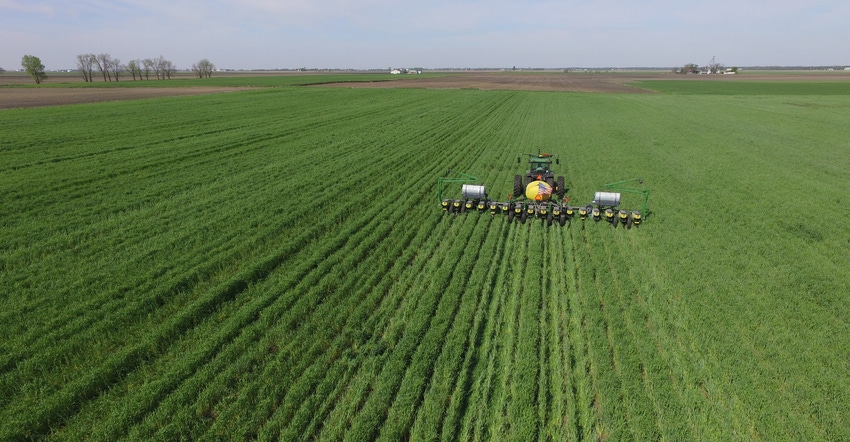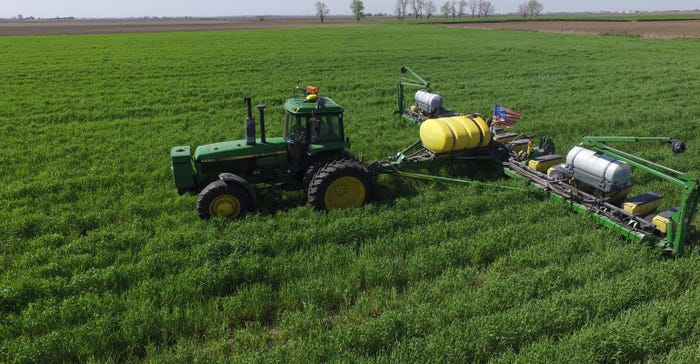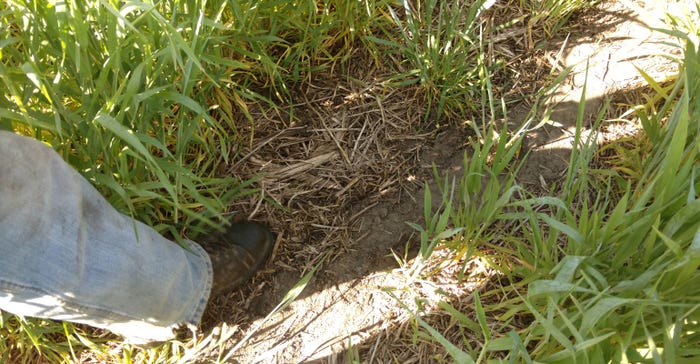
No-till farmers have to be ready to make adjustments just like anyone else. That’s especially true if they include cover crops in their plans. Cody Styck and his family are no exception. They were featured on the Indiana Farm Management Tour in 2016, and Styck spent time discussing why he believed in cover crops. The family farms near Morocco and Brook in northwest Indiana.
Styck still believes in cover crops. However, he got firsthand experience this year with needing to make adjustments on the go as weather conditions changed. The result was that he planted corn into a green cover crop, even though he didn’t originally intend to do so. He says he was excited to try it, but it made him nervous at the same time.
Daniel Perkins, an Indiana certified crop adviser and district watershed coordinator with the Jasper County Soil and Water Conservation District, visited Styck as he planted, and documented planting into a green cover crop in pictures. Thanks to Styck for sharing his story and to Perkins for sharing the photos he took. Styck was recently recognized as a National Wildlife Federation Cover Crop Champion.
Look for updates on this field later.
Here is the step-by-step timeline that led to planting corn into the green rye cover crop.
June 2016. As part of the Indiana Farm Management Tour, at Fair Oaks Dairy Adventure, Styck explained why he believes in cover crops. For example, the farm where he planted into rye cover this spring had been tilled in the fall and the spring until just a few years ago. Styck is trying to build up the soil and add organic matter with the help of cover crops.
Late summer 2016. On their farm near Brook, the Stycks attached a seeder to a high-clearance rig. They applied 50 pounds of cereal rye per acre before harvesting soybeans.
Mid-fall 2016. Styck strip-tilled into the rye cover crop. “It worked well as far as the cover crop goes,” he says. “We had a few issues that day with an RTK malfunction. As a result, some of the rows had curves in them. The intent had been to plant back on the same strips in the spring.”

COVERS IN STRIP TILL: Cody Styck sowed cereal rye first and then made strips last fall into the rye cover crop. He planted on the strips as much as possible this spring. (Photo by Daniel Perkins)

Early April 2017. Weather conditions were warm and the rye took off. This field was a distance away from where Styck lives. Rye grew faster there and was bigger than he expected.
Week of April 17. Styck typically clears strips again before planting. “We soon found out that the rye was big enough that it was interfering, so we decided to plant into it as it was. We also decided to spray the rye with glyphosate.”
April 25. The rye was still green, but the forecast was for a strong threat of rain from midweek on. “We wanted to plant before it rained, so we decided to plant into it green,” Styck says. “It wasn’t what we intended to do.”
Perkins says Styck could plant that day while neighbors couldn’t because his field with the rye cover crop was drier.
“Most of the time I could stay on the strip,” Styck says. “It was 6 to 8 inches in places, but only 4 to 6 inches in other places. I was still fairly happy with how the trench closed in most places.”

CLOSE TRENCH: In most parts of the field, the seed slot closed well. There were some issues where an RTK malfunction in the fall while making strips caused curves in a few areas. (Photo by Daniel Perkins)

Styck applied a rate of 30 units of nitrogen per acre when he started planting, and upped it to 40 pounds per acre after Perkins arrived and they discussed options.
Rest of April into early May. Perkins recommended scouting for armyworms and other pests. Armyworm moth counts reported by Purdue University were high. Styck will continue scouting. Armyworms need to be caught early because they can feed and do lots of damage quickly. Stay tuned!
About the Author(s)
You May Also Like




